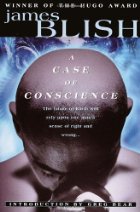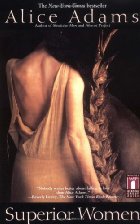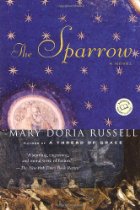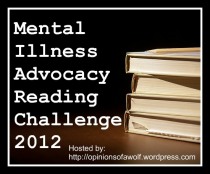Archive
Book Review: A Case of Conscience by James Blish (Series, #4)
 Summary:
Summary:
A new inhabited planet, Lithia, has been discovered, and an exploratory Earth crew of four is sent to determine how Earth will respond to the planet. Ruiz-Sanchez is a scientist and a member of this crew, but he’s also a Jesuit priest. Although he admires and respects the reptilian-humanoid inhabitants of Lithia, he soon decides that the socialist, perfectly co-existing society must be an illusion of Satan, so he advises against maintaining ties with the planet. The vote of the crew is a tie, however, so the UN must ultimately decide the fate. While they are awaiting the decision, Ruiz-Sanchez and the others must raise and guardian a Lithian child who is sent as a present to Earth. Soon, Ruiz-Sanchez starts having fears about just who the child might be.
Review:
This is the third book from the collection of 1950s American scifi classics from Netgalley, which I will review as a whole at a future date. I was surprised that a book that is fourth in its series was included in the collection. Upon investigation, I discovered that this series isn’t surrounding a certain set of events or characters but instead is multiple books around a similar theme. The theme for the series is each book deals with some aspect of the price of knowledge. So each book works as a standalone as well. There is also some disagreement as to precisely what book is what number in the series. I have chosen to use the number used by GoodReads. I had previously read a scifi book with a Jesuit priest scientist visiting a newly found planet (The Sparrow by Mary Doria Russell, review) and loved it, so I was excited to see a similar idea executed differently. Unfortunately, I found that this book lacked the nuance and subtlety that made The Sparrow
such a lovely read.
Ruiz-Sanchez is a rather two-dimensional character who quickly turns into a bumbling priest trope. Very little attention is paid to his credentials as a scientist within the story, so instead of coming to know Ruiz-Sanchez the scientist, the man, and the priest, we only know him in his priest role. This prevents a connection or even a basic understanding of his rather bizarre concerns. Whereas in The Sparrow, the priest wonders how a new planet can be covered by salvation and has a meaningful crisis of faith, in A Case of Conscience, the priest is just busy seeing demons and Satan and the Anti-Christ everywhere in such a bizarre, unbelievable manner that he may as well be holding an end of the world sign on a street corner. It’s almost impossible to connect with him on this level unless the reader also has a tendency to see illusions of Satan and the end of the world everywhere they look.
The plot is fascinating, although it does jump around a lot. Essentially there’s the part on Lithia, which primarily consists of discourse between the scientists. Then there’s the development of the Lithian child into an adult who doesn’t fit anywhere, since he lacked the social training on Lithia and also is a reptilian humanoid on planet Earth. He then starts to incite rebellion among the youth. Meanwhile, Ruiz-Sanchez is told by the Pope that he committed an act of heresy and he must re-win favor by stopping the Anti-Christ aka the Lithian on Earth. All of the settings are fascinating, and the plot is certainly fast-paced. However, the plot is so far-fetched that it is difficult to properly suspend disbelief for it.
The settings are the strength of the book. Lithia is well-imagined, with uniqueness from Earth in everything from technology to how the Lithians handle child-rearing. The tech involves trees since they lack minerals, and the child-rearing is non-existent. The Lithians are simply birthed then allowed to develop on the planet, similar to turtles on Earth. Earth’s setting is interestingly imagined as well. The fear of nuclear weapons has driven humans to live underground for generations with only the elite living above ground, and the UN working hard to keep it that way. It’s a fun mix of alternate alien civilization and dystopia.
Essentially, the book has interesting world-building and what could be a promising plot that get derailed by two-dimensional characters and too many bizarre plot-twists and occurrences. It’s certainly an interesting read, particularly if you are interested in immersing yourself in this odd world Blish has created. However, readers should not expect to connect with the characters on an emotional level and should be prepared for a bizarre plot.
3 out of 5 stars
Source: Netgalley
Previous Books in Series:
Doctor Mirabilis
Black Easter
The Day After Judgement
The Devil’s Day (books 2 and 3 published as one book)
Book Review: Superior Women by Alice Adams (Bottom of TBR Pile Challenge)
 Summary:
Summary:
When Californian Megan Greene runs has a steamy affair in the summer of 1943 with a Harvard student visiting the west coast for the summer, she decides to follow him back to the east coast and attend Radcliffe. There she meets four other women, three of whom it might be more accurate to call frenemies than friends. Their lives and destinies repeatedly intertwine throughout the tumultuous changes of mid-20th century America.
Review:
I kept my eye out for this book when it was named as a read-a-like to my 2011 5 star read The Group (review) by Mary McCarthy. So when I saw it on a Better World Books sale list, I ordered a copy. I can see why this was named as a read-a-like. Both books view a historical time period through a group of women who attended a women’s college together. What McCarthy wrote stunningly and with subtlety, though, Adams wrote in a barely above-average fashion.
The book covers 1940s to 1980s America, yet as the decades move on, less and less is said. The 1940s are expressed clearly with exquisite detail, and I was excited to see what would happen with the 1950s and the 1960s. But the 1950s slowed down, the 1960s were barely touched upon, the 1970s were jumped over almost entirely, and the 1980s were the final chapter of the book. The pacing was all off. I wanted to know these women in as much detail in the latter decades as in the first. Instead of feeling like I knew them more and more intimately, they increasingly became strangers to me.
One thing that I think really works against the book is it is neither an ensemble nor a one character piece. Most of the book is told about Megan, but not all of it. We get snippets of the other characters, meaning perspectives that Megan is not privy to, but not enough to ever truly know them. Since most of the book is about Megan, these bits away from her feel sort of like the story is robbing us of more time with the main character we are interested in. Similarly, reading the blurb and the title, I thought this was going to be an ensemble book, which is not what we get either. I wanted to know much more about two of the characters in particular, Peg, who comes out as a lesbian at some point in the 1960s, and Cathy, who has an affair with a priest. These two stories are wonderfully intriguing, particularly Peg’s since her love of her life is met on a mission to register black voters in the American south, and her love interest is a Latina woman. There is so much meat to that storyline, and yet it is barely touched upon while we instead listen to Megan hem and haw about her job, and Lavinia try to figure out how best to cheat on her husband. The balance of telling this ensemble piece was just entirely off.
Similarly, while big issues and events of mid-20th century America were briefly touched upon, the book never really presented a truly personal look at any of them. For instance, Megan has a friend who is bashed in a drive-by gay bashing but we never get to see Megan emotionally deal with this stark reality. She hears about it, calls him, and moves on. Similarly, as previously mentioned, Peg comes out as a lesbian, and we see a snippet of her depression caused by living the lie of being straight, but we never get to understand the emotions or impetus behind her bravely coming out and living in a visible, inter-racial lesbian relationship in the south. It is disappointing because we get a taste of really encountering these historical issues, but we never actually get to.
In spite of all these problems, I still enjoyed reading the book well enough. The plot, while frustrating, does progress forward in an interesting fashion. The characters, although frequently two-dimensional, are bright and vivid. I came away with the perspective I always have with historical fiction about women’s history. That I am grateful I was born in a different time, because we women have much more opportunities available to us now. So I appreciated my visit to that time period but it was a bit disappointing.
Overall, if you are a huge fan of historical fiction about women’s issues, this is an interesting book to add to your repertoire. It is a good comparison to others that did it differently or better, and it is still fun to visit those time periods. If this type of literature is not generally your cup of tea, though, I would suggest you instead read stronger competitors in that genre, such as The Group.
3.5 out of 5 stars
Book Review: The Sparrow by Mary Doria Russell (Series, #1) (Bottom of TBR Pile Challenge)
 Summary:
Summary:
It is the year 2060, and the Jesuit priest Emilio Endoz has been found on the planet Rakhat by the second Earth ship to travel there. Found in a whorehouse and killing a native inhabitant in front the UN members’ eyes, they nonetheless strap him into his original spaceship and send him back to the Jesuits. There he is treated for his horrifying wounds and through a series of flashbacks and current conversations with the various Jesuit committee members assigned to his case, we slowly see how everything that started out so right went so horribly wrong on Rakhat.
Review:
It may have been a while since it made it onto my tbr shelf, but I still have a crystal clear memory of why I acquired this book. I entirely blame Little Red Reviewer, who just so happens to be the only other female scifi fan who book blogs that I’m aware of. (Feel free to enlighten me to more in the comments). Her review that religion is there but in a questioning way that honors the tradition of scifi made me give this book with a Jesuit priest and mission at its core a chance. I’m glad I did.
This is a first contact story that takes the all-too-infrequent route of Earth finding the inhabited planet first and sending a mission to them. There’s so much more than that that makes this book unique, though. The future Earth just barely has the technology to make it to Alpha Centauri, and only the most tech-savvy are aware of it. Thus, we’re not an incredibly advanced civilization making first contact, just one slightly more so than Rakhat. I’d say a fair comparison might be late 19th to early 20th century earth to early to late 21st century Earth. It’s a short span of difference. Additionally, Russell made the intriguing choice of the first contact being run by missionaries, instead of a political unit. When you think about it, it makes perfect sense. Who tended to be first to the New World? Religious groups. Who can organize themselves quickly and have vast finances? Religious groups. Having first contact be missionaries makes so much sense that I’m shocked I didn’t think of it first.
That said, thankfully this book is not a love letter to organized religion or mission work. It is instead a complex, scientific, and anthropological study of the human condition, the difficulties of vastly different cultures meeting, linguistics, and much more. At its core it is all about why does god (if there is a god) let evil happen, especially to good people who are serving him? These issues are more easily addressed and made further complex by having agnostics, non-practicing Catholics, and a Jewish woman members of the mission team. The non-believers are about at even numbers with the priests. In fact, the deeper into the book I got, the more it tore at my heart-strings. Varying types of questioners are represented, and of course it’s possible to identify with many of them, particularly for a reader who once was religious but is not anymore. There’s the priest who is secretly gay, the Jewish woman who was wounded terribly by war but comes to learn to love again, the Father Superior who thinks he may be seeing the formation of a real live saint, the priest questioning the very existence of god, and the agnostic who wants to have the beautiful aspect of faith that she sees in those around her.
This book reads, it sounds a bit odd to say, almost like an agnostic’s prayer. Of course agnostics don’t pray, but if they did pray, the pain and wondering and intelligence found in this book would all be there.
We are, after all, only very clever tailless primates, doing the best we can, but limited. Perhaps we must all own up to being agnostic, unable to know the unknowable. (page 201)
The problem with atheism, I find, under these circumstances…is that I have no one to despise but myself. If, however, I choose to believe that God is vicious, then at least I have the solace of hating God. (page 394)
People more into science than the questioning human spirit will find plenty for themselves as well. The science of linguistics is astoundingly well presented. The way the two “sentient” species on Rakhat have evolved is also incredibly well thought-out and realistically drawn. The problems of poverty and war on earth are briefly explored too.
All of these things said, I do feel it took a bit too long to get things set up and moving. Granted, I tend to be a bit of an action-focused reader, so others may not have a problem with that. It was still a draw-back of the book for me though.
I sort of feel like I’m not doing the experience of reading this book justice. Suffice to say if you’ve ever questioned whether or not to have faith and love your big questions to be wrapped in well-thought-out scifi, this is the book for you.
4 out of 5 stars
Source: Better World Books



